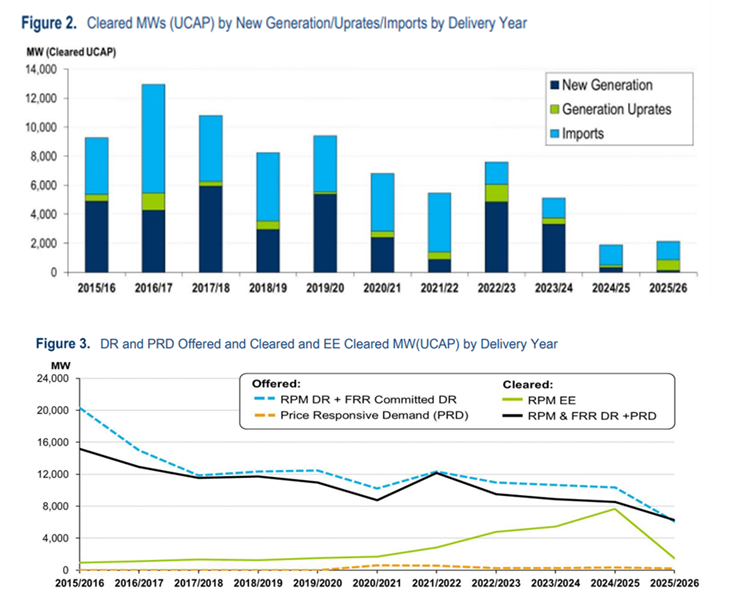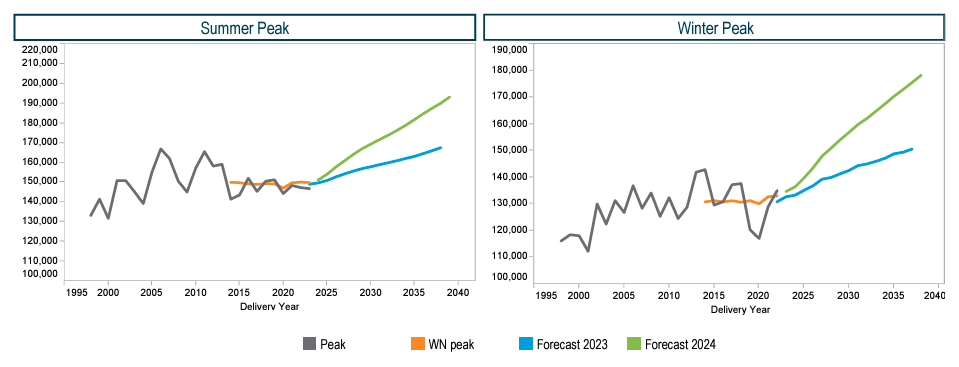The latest PJM capacity auction has created a buzz throughout the energy market, with record-high prices that will have a lasting impact on consumers and businesses across the region. As PJM struggles to keep up with the rapid energy transition, rising capacity costs highlight the need for flexible resilient grid strategies to help businesses reduce costs and the grid to remain reliable.
What Happened: Capacity Prices Hit Record Highs
In the most recent capacity auction, PJM saw bids 6,600 MW lower compared to the previous auction and faced a shortfall in new generation bids by nearly 220 MW. In addition, the Installed Reserve Margin (IRM) rose significantly from 14.7% to 17.8%, a change that signals increased concern over reliability as the region contends with tight supply and higher demand. “PJM didn’t prepare for an energy transition we all saw coming, and now consumers are going to pay the price,” says Jon Gordon, a director at Advanced Energy United. This sentiment underscores the difficulties PJM faces in balancing its role in a decarbonizing landscape with the operational and financial realities of legacy infrastructure.
Why Did Prices Surge?
Several converging factors have driven this unprecedented price hike:
- Plant Retirements: A significant number of coal, gas, and nuclear plants have retired or announced retirements, in addition to long queues for connecting renewable projects leading to reduced capacity.
- Rising Demand: As electrification accelerates, particularly in transportation and industry, overall load has increased, compounding capacity strain.
- Market Rule Changes: Adjustments to PJM’s market rules have impacted both new and existing generators, making it more challenging to introduce new resources.
- Lower Participation in the Auction: Nearly 220 MW less generation capacity bid in this auction compared to prior years, partly because certain reliability-must-run (RMR) resources don’t participate in these auctions, further limiting options.

Why It Matters for Consumers and the Grid
The shortage in capacity is already impacting prices across all PJM zones, and businesses are feeling the heat. The rise in capacity costs means higher energy bills, which is leading businesses and households to seek ways to manage their energy use more efficiently.
- Increased Demand for Cost-Saving Measures: With capacity costs rising, consumers are more motivated than ever to explore demand response programs, peak load management, and distributed energy resources (DERs) to mitigate costs.
- Accelerated Project Approvals: To address the shortfall, PJM is looking to fast-track shovel-ready projects that could quickly add capacity. This push highlights an ongoing effort to balance the need for reliable energy with a rapid shift to renewable resources.
- Rising Energy Demand: With a rise in electrification and more data centers coming online, demand is projected to increase significantly over the coming years in PJM.
Projected energy demand for PJM

The Role of DR and Peak Management
To help consumers manage the rising capacity prices, demand response (DR) and peak load management are becoming essential strategies. Through demand response programs, consumers receive incentives to reduce their electricity usage during peak demand periods, which helps alleviate strain on the grid. This flexibility is key in preventing further capacity shortfalls and supporting grid stability, especially as traditional power sources retire.
Additionally, capacity and transmission peak load management solutions allow consumers to actively lower their load during critical times, which can result in significant cost savings on energy bills. These strategies not only benefit individual consumers but also contribute to overall grid resilience by reducing the need for emergency generation and keeping capacity prices more stable.
As PJM faces challenges in securing adequate capacity, demand response and peak load management stand out as vital tools to empower consumers and balance supply and demand in a rapidly evolving energy landscape.
What’s Next: PJM’s Path Forward
To stabilize prices, PJM will need to continue adjusting market rules, incentivize new generation, and foster quicker integration of renewable energy sources. This transition won’t happen overnight, but by proactively planning for the future, PJM can ensure a more resilient and affordable grid for all consumers.
Adopt Energy Solutions for Business Savings
The rise in PJM capacity prices reveals the challenges of transitioning to a cleaner grid while maintaining reliability. For consumers, now is the time to adopt energy management solutions that can help offset these costs and reduce demand on an already constrained system.
For businesses looking to reduce their energy costs, manage their consumption, or meet sustainability goals – the time to act is now to get a plan in place and take action. Reach out to Rodan Energy and see how we can help your business with our innovative and customized energy solutions.




